BAA215 Corporate Law: Good Faith and Proper Purpose Analysis Report
VerifiedAdded on 2022/12/29
|10
|2850
|45
Report
AI Summary
This report examines the legal concepts of good faith and proper purpose within the context of Australian corporate law, specifically focusing on the Corporations Act 2001. It explores the duties imposed on company directors, secretaries, and officers, emphasizing their obligation to act in good faith and for a proper purpose, keeping the best interests of the corporation in mind. The paper delves into the definitions and functions of good faith and proper purpose, drawing on case law such as ASIC v Adler and ASIC v Warrenmang Ltd to illustrate the application of these principles. The report also discusses corporate governance, fiduciary relationships, and the potential consequences of breaching these duties. It highlights the importance of directors' actions in maintaining the integrity of the organization and protecting the interests of stakeholders. The analysis further includes an examination of the implied and expressed terms related to good faith in contracts, with reference to the AS11000 amendment and its implications. Finally, the report provides a comprehensive overview of the legal framework surrounding the duties of directors and the factors considered when determining a breach of proper purpose.
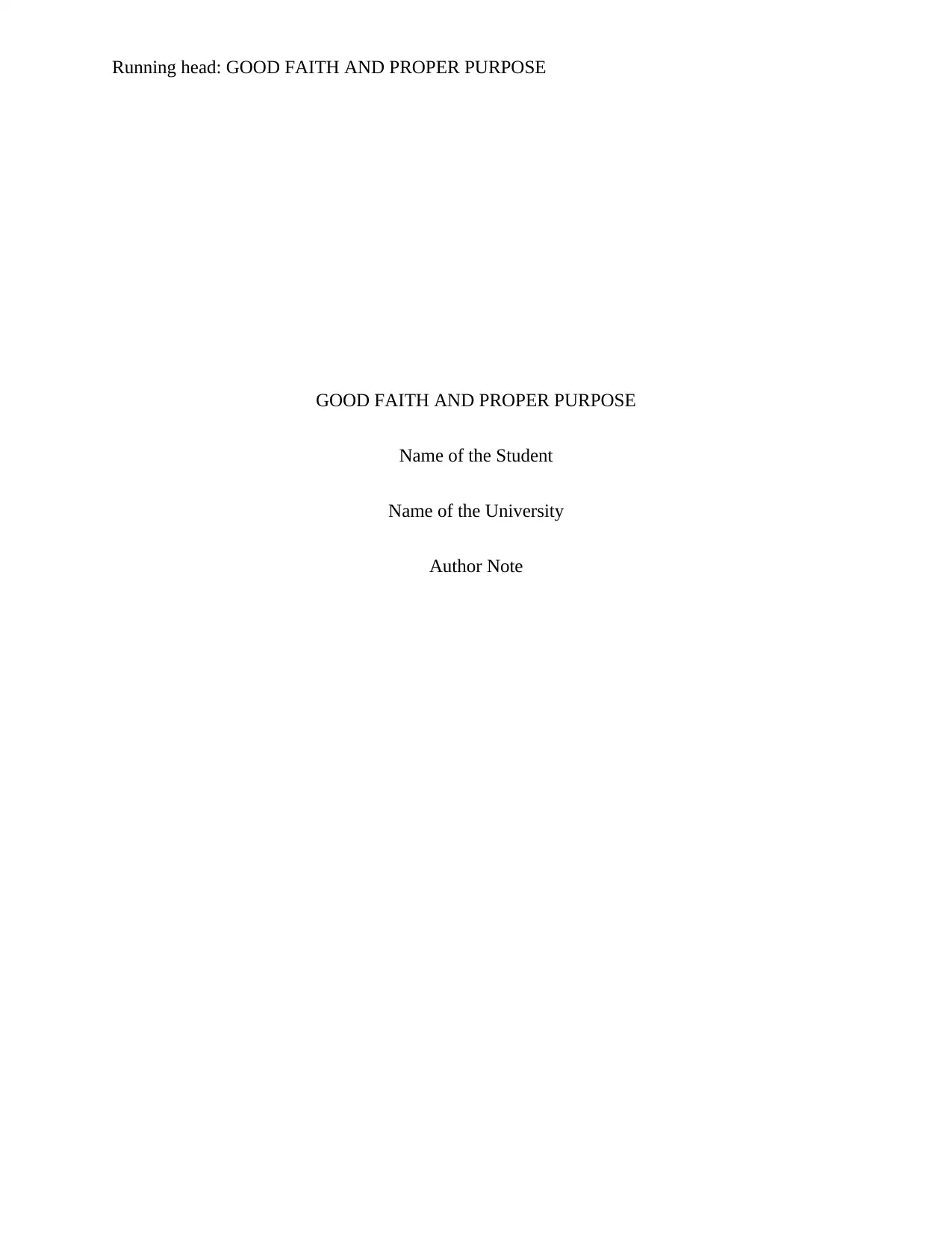
Running head: GOOD FAITH AND PROPER PURPOSE
GOOD FAITH AND PROPER PURPOSE
Name of the Student
Name of the University
Author Note
GOOD FAITH AND PROPER PURPOSE
Name of the Student
Name of the University
Author Note
Paraphrase This Document
Need a fresh take? Get an instant paraphrase of this document with our AI Paraphraser
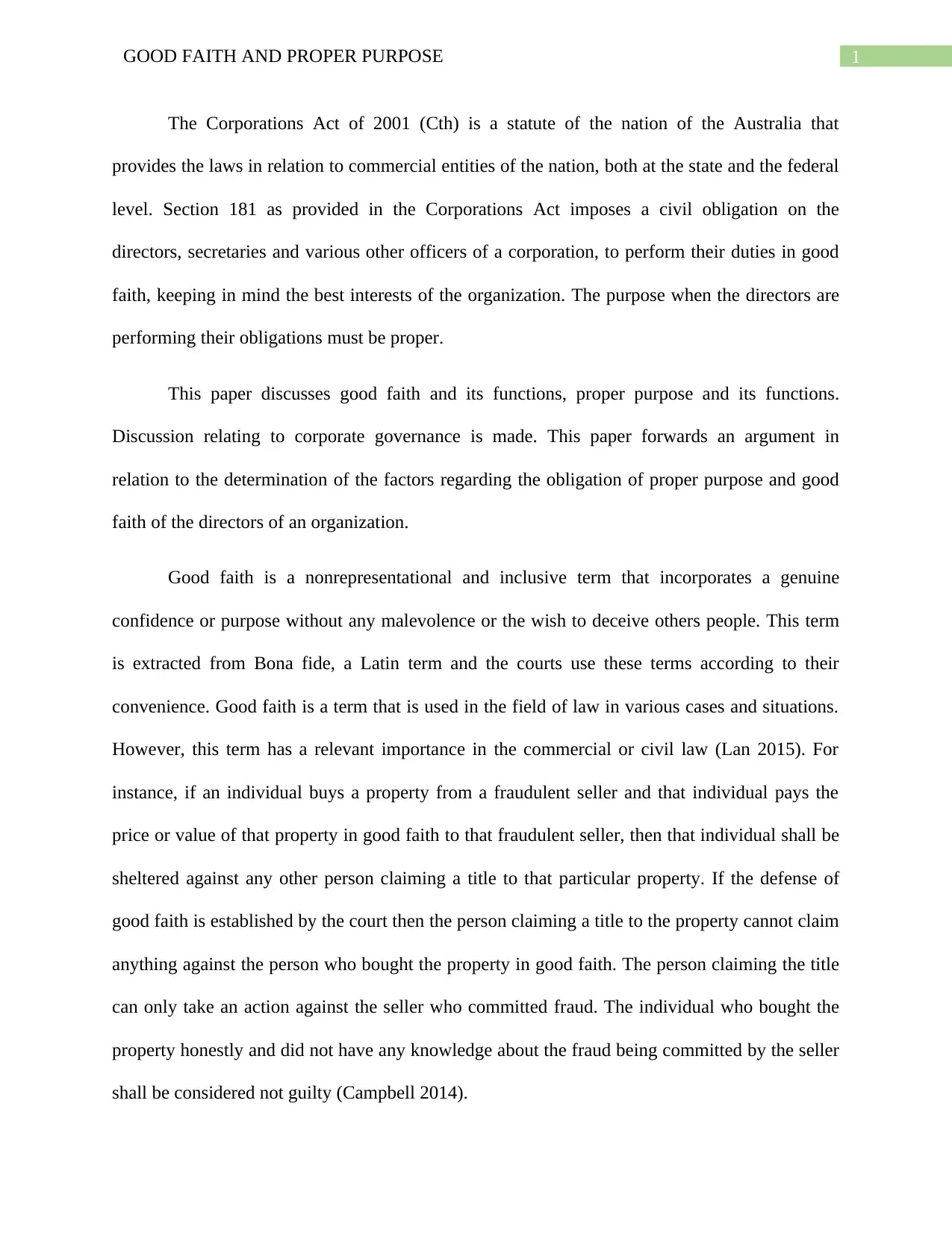
1GOOD FAITH AND PROPER PURPOSE
The Corporations Act of 2001 (Cth) is a statute of the nation of the Australia that
provides the laws in relation to commercial entities of the nation, both at the state and the federal
level. Section 181 as provided in the Corporations Act imposes a civil obligation on the
directors, secretaries and various other officers of a corporation, to perform their duties in good
faith, keeping in mind the best interests of the organization. The purpose when the directors are
performing their obligations must be proper.
This paper discusses good faith and its functions, proper purpose and its functions.
Discussion relating to corporate governance is made. This paper forwards an argument in
relation to the determination of the factors regarding the obligation of proper purpose and good
faith of the directors of an organization.
Good faith is a nonrepresentational and inclusive term that incorporates a genuine
confidence or purpose without any malevolence or the wish to deceive others people. This term
is extracted from Bona fide, a Latin term and the courts use these terms according to their
convenience. Good faith is a term that is used in the field of law in various cases and situations.
However, this term has a relevant importance in the commercial or civil law (Lan 2015). For
instance, if an individual buys a property from a fraudulent seller and that individual pays the
price or value of that property in good faith to that fraudulent seller, then that individual shall be
sheltered against any other person claiming a title to that particular property. If the defense of
good faith is established by the court then the person claiming a title to the property cannot claim
anything against the person who bought the property in good faith. The person claiming the title
can only take an action against the seller who committed fraud. The individual who bought the
property honestly and did not have any knowledge about the fraud being committed by the seller
shall be considered not guilty (Campbell 2014).
The Corporations Act of 2001 (Cth) is a statute of the nation of the Australia that
provides the laws in relation to commercial entities of the nation, both at the state and the federal
level. Section 181 as provided in the Corporations Act imposes a civil obligation on the
directors, secretaries and various other officers of a corporation, to perform their duties in good
faith, keeping in mind the best interests of the organization. The purpose when the directors are
performing their obligations must be proper.
This paper discusses good faith and its functions, proper purpose and its functions.
Discussion relating to corporate governance is made. This paper forwards an argument in
relation to the determination of the factors regarding the obligation of proper purpose and good
faith of the directors of an organization.
Good faith is a nonrepresentational and inclusive term that incorporates a genuine
confidence or purpose without any malevolence or the wish to deceive others people. This term
is extracted from Bona fide, a Latin term and the courts use these terms according to their
convenience. Good faith is a term that is used in the field of law in various cases and situations.
However, this term has a relevant importance in the commercial or civil law (Lan 2015). For
instance, if an individual buys a property from a fraudulent seller and that individual pays the
price or value of that property in good faith to that fraudulent seller, then that individual shall be
sheltered against any other person claiming a title to that particular property. If the defense of
good faith is established by the court then the person claiming a title to the property cannot claim
anything against the person who bought the property in good faith. The person claiming the title
can only take an action against the seller who committed fraud. The individual who bought the
property honestly and did not have any knowledge about the fraud being committed by the seller
shall be considered not guilty (Campbell 2014).
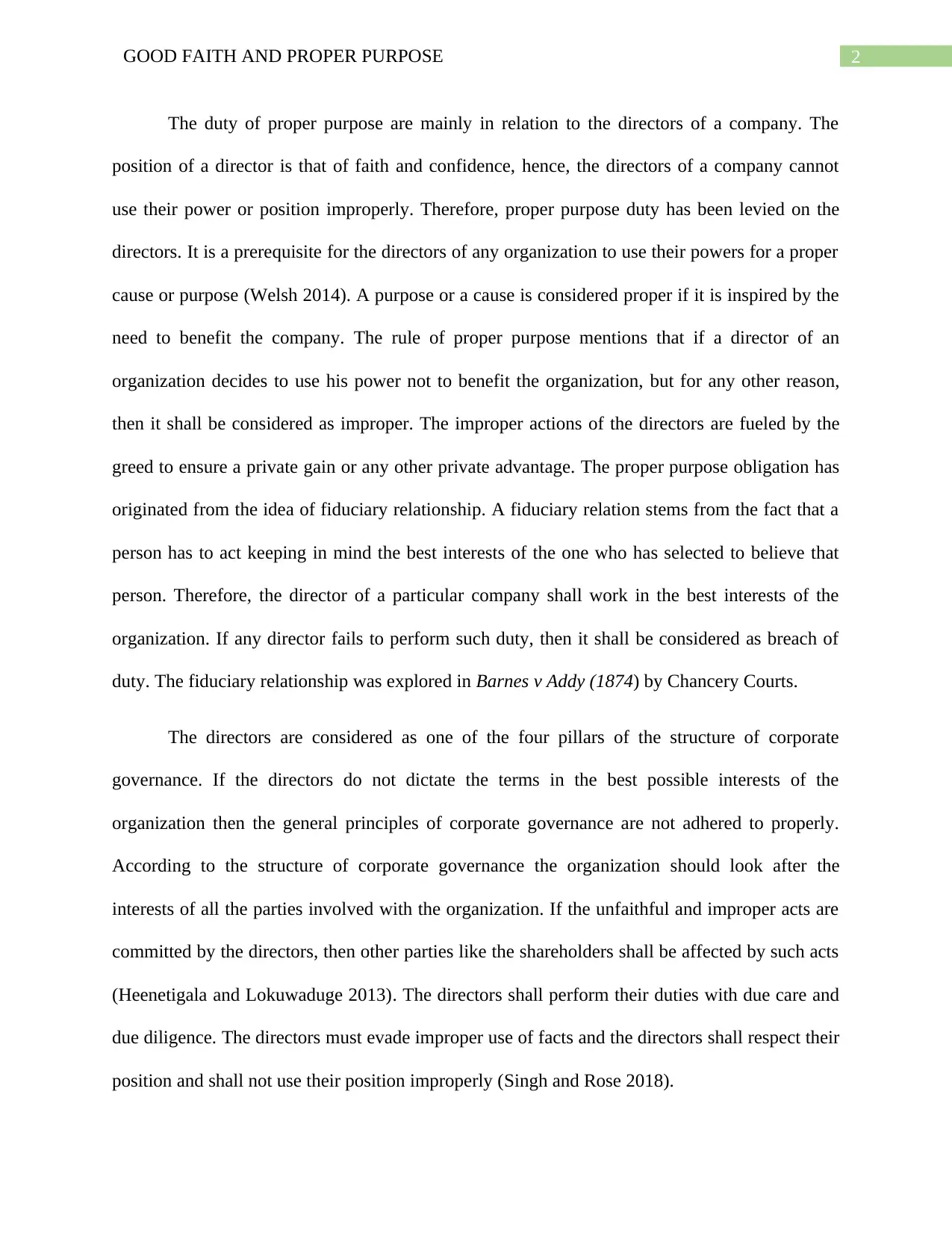
2GOOD FAITH AND PROPER PURPOSE
The duty of proper purpose are mainly in relation to the directors of a company. The
position of a director is that of faith and confidence, hence, the directors of a company cannot
use their power or position improperly. Therefore, proper purpose duty has been levied on the
directors. It is a prerequisite for the directors of any organization to use their powers for a proper
cause or purpose (Welsh 2014). A purpose or a cause is considered proper if it is inspired by the
need to benefit the company. The rule of proper purpose mentions that if a director of an
organization decides to use his power not to benefit the organization, but for any other reason,
then it shall be considered as improper. The improper actions of the directors are fueled by the
greed to ensure a private gain or any other private advantage. The proper purpose obligation has
originated from the idea of fiduciary relationship. A fiduciary relation stems from the fact that a
person has to act keeping in mind the best interests of the one who has selected to believe that
person. Therefore, the director of a particular company shall work in the best interests of the
organization. If any director fails to perform such duty, then it shall be considered as breach of
duty. The fiduciary relationship was explored in Barnes v Addy (1874) by Chancery Courts.
The directors are considered as one of the four pillars of the structure of corporate
governance. If the directors do not dictate the terms in the best possible interests of the
organization then the general principles of corporate governance are not adhered to properly.
According to the structure of corporate governance the organization should look after the
interests of all the parties involved with the organization. If the unfaithful and improper acts are
committed by the directors, then other parties like the shareholders shall be affected by such acts
(Heenetigala and Lokuwaduge 2013). The directors shall perform their duties with due care and
due diligence. The directors must evade improper use of facts and the directors shall respect their
position and shall not use their position improperly (Singh and Rose 2018).
The duty of proper purpose are mainly in relation to the directors of a company. The
position of a director is that of faith and confidence, hence, the directors of a company cannot
use their power or position improperly. Therefore, proper purpose duty has been levied on the
directors. It is a prerequisite for the directors of any organization to use their powers for a proper
cause or purpose (Welsh 2014). A purpose or a cause is considered proper if it is inspired by the
need to benefit the company. The rule of proper purpose mentions that if a director of an
organization decides to use his power not to benefit the organization, but for any other reason,
then it shall be considered as improper. The improper actions of the directors are fueled by the
greed to ensure a private gain or any other private advantage. The proper purpose obligation has
originated from the idea of fiduciary relationship. A fiduciary relation stems from the fact that a
person has to act keeping in mind the best interests of the one who has selected to believe that
person. Therefore, the director of a particular company shall work in the best interests of the
organization. If any director fails to perform such duty, then it shall be considered as breach of
duty. The fiduciary relationship was explored in Barnes v Addy (1874) by Chancery Courts.
The directors are considered as one of the four pillars of the structure of corporate
governance. If the directors do not dictate the terms in the best possible interests of the
organization then the general principles of corporate governance are not adhered to properly.
According to the structure of corporate governance the organization should look after the
interests of all the parties involved with the organization. If the unfaithful and improper acts are
committed by the directors, then other parties like the shareholders shall be affected by such acts
(Heenetigala and Lokuwaduge 2013). The directors shall perform their duties with due care and
due diligence. The directors must evade improper use of facts and the directors shall respect their
position and shall not use their position improperly (Singh and Rose 2018).
⊘ This is a preview!⊘
Do you want full access?
Subscribe today to unlock all pages.

Trusted by 1+ million students worldwide
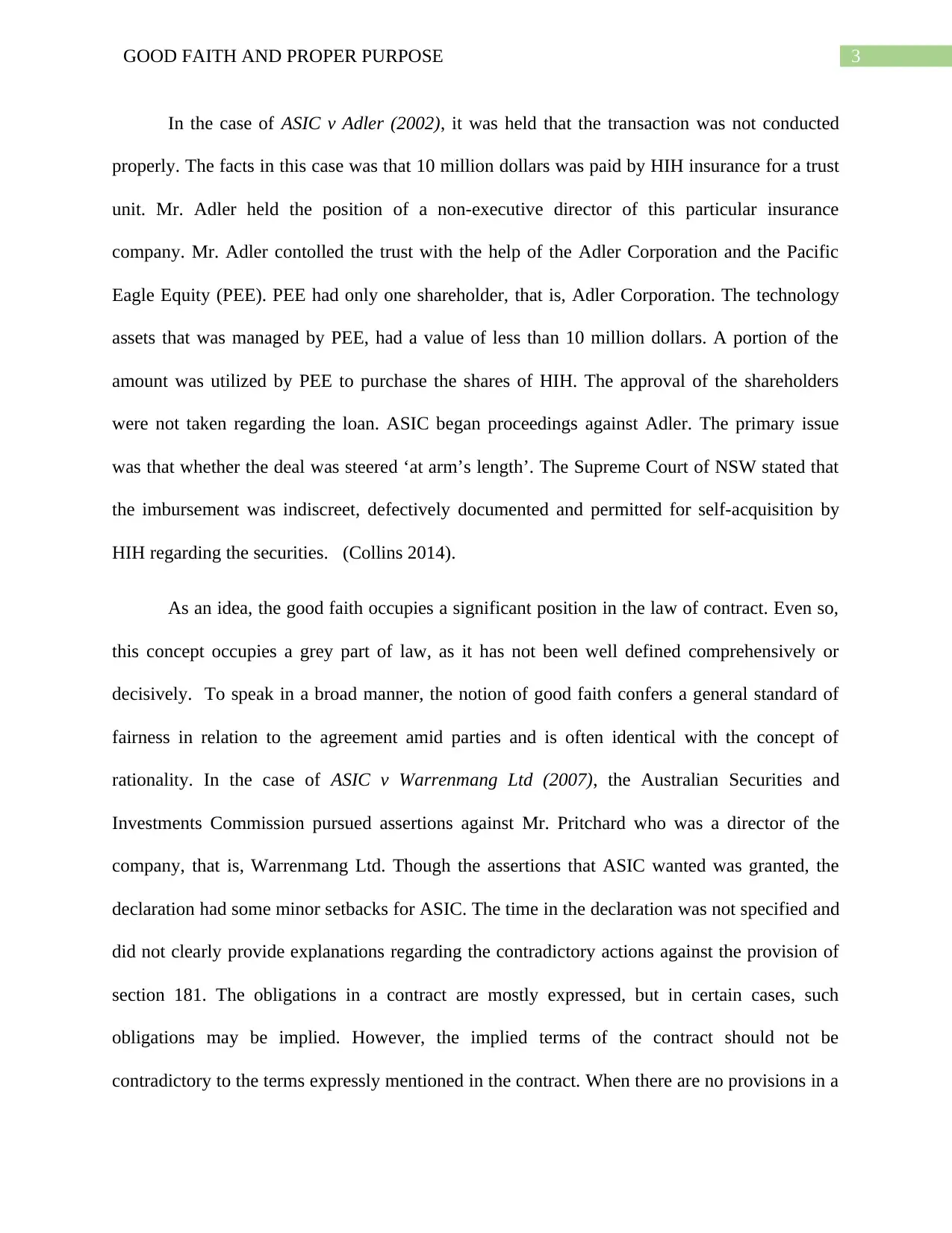
3GOOD FAITH AND PROPER PURPOSE
In the case of ASIC v Adler (2002), it was held that the transaction was not conducted
properly. The facts in this case was that 10 million dollars was paid by HIH insurance for a trust
unit. Mr. Adler held the position of a non-executive director of this particular insurance
company. Mr. Adler contolled the trust with the help of the Adler Corporation and the Pacific
Eagle Equity (PEE). PEE had only one shareholder, that is, Adler Corporation. The technology
assets that was managed by PEE, had a value of less than 10 million dollars. A portion of the
amount was utilized by PEE to purchase the shares of HIH. The approval of the shareholders
were not taken regarding the loan. ASIC began proceedings against Adler. The primary issue
was that whether the deal was steered ‘at arm’s length’. The Supreme Court of NSW stated that
the imbursement was indiscreet, defectively documented and permitted for self-acquisition by
HIH regarding the securities. (Collins 2014).
As an idea, the good faith occupies a significant position in the law of contract. Even so,
this concept occupies a grey part of law, as it has not been well defined comprehensively or
decisively. To speak in a broad manner, the notion of good faith confers a general standard of
fairness in relation to the agreement amid parties and is often identical with the concept of
rationality. In the case of ASIC v Warrenmang Ltd (2007), the Australian Securities and
Investments Commission pursued assertions against Mr. Pritchard who was a director of the
company, that is, Warrenmang Ltd. Though the assertions that ASIC wanted was granted, the
declaration had some minor setbacks for ASIC. The time in the declaration was not specified and
did not clearly provide explanations regarding the contradictory actions against the provision of
section 181. The obligations in a contract are mostly expressed, but in certain cases, such
obligations may be implied. However, the implied terms of the contract should not be
contradictory to the terms expressly mentioned in the contract. When there are no provisions in a
In the case of ASIC v Adler (2002), it was held that the transaction was not conducted
properly. The facts in this case was that 10 million dollars was paid by HIH insurance for a trust
unit. Mr. Adler held the position of a non-executive director of this particular insurance
company. Mr. Adler contolled the trust with the help of the Adler Corporation and the Pacific
Eagle Equity (PEE). PEE had only one shareholder, that is, Adler Corporation. The technology
assets that was managed by PEE, had a value of less than 10 million dollars. A portion of the
amount was utilized by PEE to purchase the shares of HIH. The approval of the shareholders
were not taken regarding the loan. ASIC began proceedings against Adler. The primary issue
was that whether the deal was steered ‘at arm’s length’. The Supreme Court of NSW stated that
the imbursement was indiscreet, defectively documented and permitted for self-acquisition by
HIH regarding the securities. (Collins 2014).
As an idea, the good faith occupies a significant position in the law of contract. Even so,
this concept occupies a grey part of law, as it has not been well defined comprehensively or
decisively. To speak in a broad manner, the notion of good faith confers a general standard of
fairness in relation to the agreement amid parties and is often identical with the concept of
rationality. In the case of ASIC v Warrenmang Ltd (2007), the Australian Securities and
Investments Commission pursued assertions against Mr. Pritchard who was a director of the
company, that is, Warrenmang Ltd. Though the assertions that ASIC wanted was granted, the
declaration had some minor setbacks for ASIC. The time in the declaration was not specified and
did not clearly provide explanations regarding the contradictory actions against the provision of
section 181. The obligations in a contract are mostly expressed, but in certain cases, such
obligations may be implied. However, the implied terms of the contract should not be
contradictory to the terms expressly mentioned in the contract. When there are no provisions in a
Paraphrase This Document
Need a fresh take? Get an instant paraphrase of this document with our AI Paraphraser
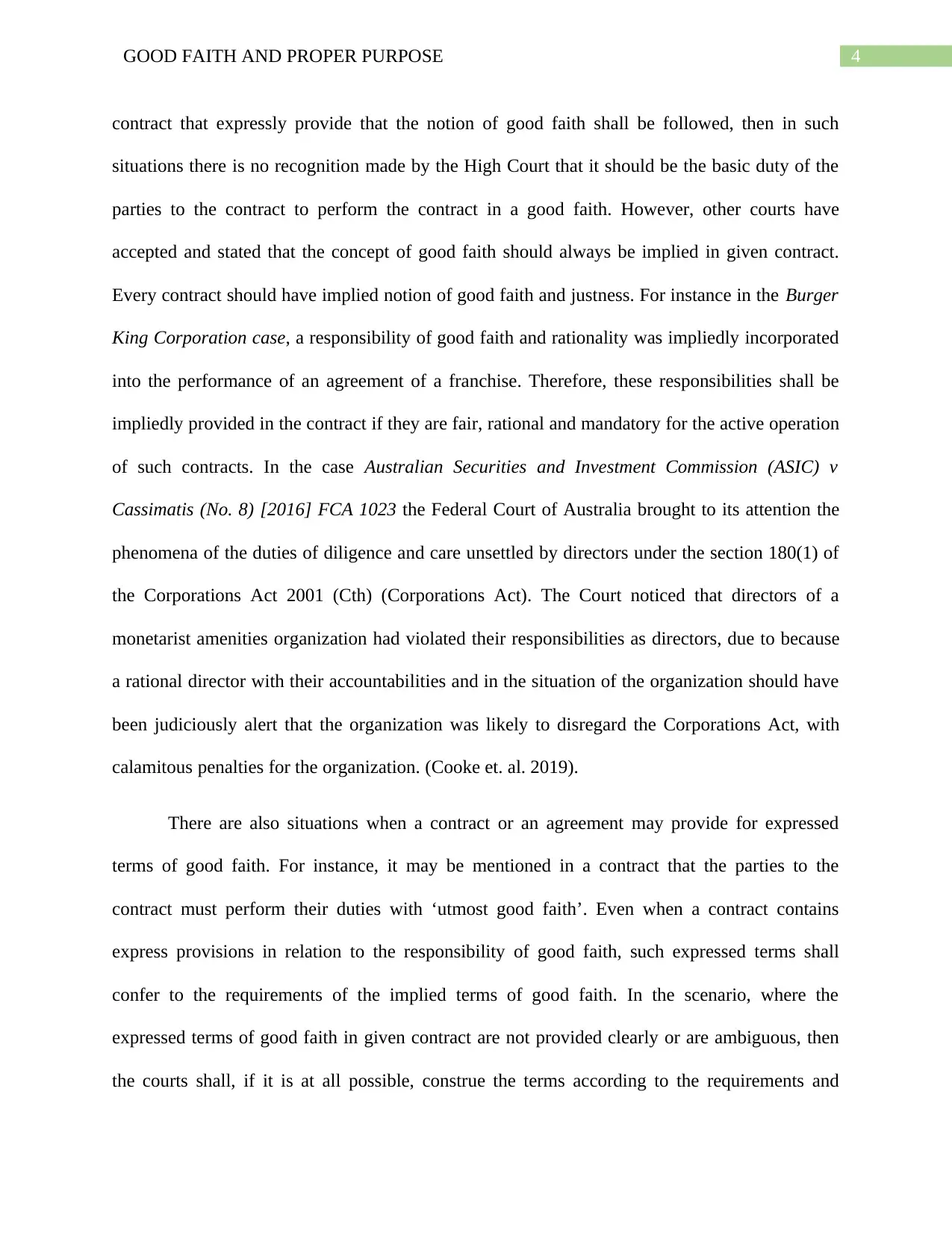
4GOOD FAITH AND PROPER PURPOSE
contract that expressly provide that the notion of good faith shall be followed, then in such
situations there is no recognition made by the High Court that it should be the basic duty of the
parties to the contract to perform the contract in a good faith. However, other courts have
accepted and stated that the concept of good faith should always be implied in given contract.
Every contract should have implied notion of good faith and justness. For instance in the Burger
King Corporation case, a responsibility of good faith and rationality was impliedly incorporated
into the performance of an agreement of a franchise. Therefore, these responsibilities shall be
impliedly provided in the contract if they are fair, rational and mandatory for the active operation
of such contracts. In the case Australian Securities and Investment Commission (ASIC) v
Cassimatis (No. 8) [2016] FCA 1023 the Federal Court of Australia brought to its attention the
phenomena of the duties of diligence and care unsettled by directors under the section 180(1) of
the Corporations Act 2001 (Cth) (Corporations Act). The Court noticed that directors of a
monetarist amenities organization had violated their responsibilities as directors, due to because
a rational director with their accountabilities and in the situation of the organization should have
been judiciously alert that the organization was likely to disregard the Corporations Act, with
calamitous penalties for the organization. (Cooke et. al. 2019).
There are also situations when a contract or an agreement may provide for expressed
terms of good faith. For instance, it may be mentioned in a contract that the parties to the
contract must perform their duties with ‘utmost good faith’. Even when a contract contains
express provisions in relation to the responsibility of good faith, such expressed terms shall
confer to the requirements of the implied terms of good faith. In the scenario, where the
expressed terms of good faith in given contract are not provided clearly or are ambiguous, then
the courts shall, if it is at all possible, construe the terms according to the requirements and
contract that expressly provide that the notion of good faith shall be followed, then in such
situations there is no recognition made by the High Court that it should be the basic duty of the
parties to the contract to perform the contract in a good faith. However, other courts have
accepted and stated that the concept of good faith should always be implied in given contract.
Every contract should have implied notion of good faith and justness. For instance in the Burger
King Corporation case, a responsibility of good faith and rationality was impliedly incorporated
into the performance of an agreement of a franchise. Therefore, these responsibilities shall be
impliedly provided in the contract if they are fair, rational and mandatory for the active operation
of such contracts. In the case Australian Securities and Investment Commission (ASIC) v
Cassimatis (No. 8) [2016] FCA 1023 the Federal Court of Australia brought to its attention the
phenomena of the duties of diligence and care unsettled by directors under the section 180(1) of
the Corporations Act 2001 (Cth) (Corporations Act). The Court noticed that directors of a
monetarist amenities organization had violated their responsibilities as directors, due to because
a rational director with their accountabilities and in the situation of the organization should have
been judiciously alert that the organization was likely to disregard the Corporations Act, with
calamitous penalties for the organization. (Cooke et. al. 2019).
There are also situations when a contract or an agreement may provide for expressed
terms of good faith. For instance, it may be mentioned in a contract that the parties to the
contract must perform their duties with ‘utmost good faith’. Even when a contract contains
express provisions in relation to the responsibility of good faith, such expressed terms shall
confer to the requirements of the implied terms of good faith. In the scenario, where the
expressed terms of good faith in given contract are not provided clearly or are ambiguous, then
the courts shall, if it is at all possible, construe the terms according to the requirements and
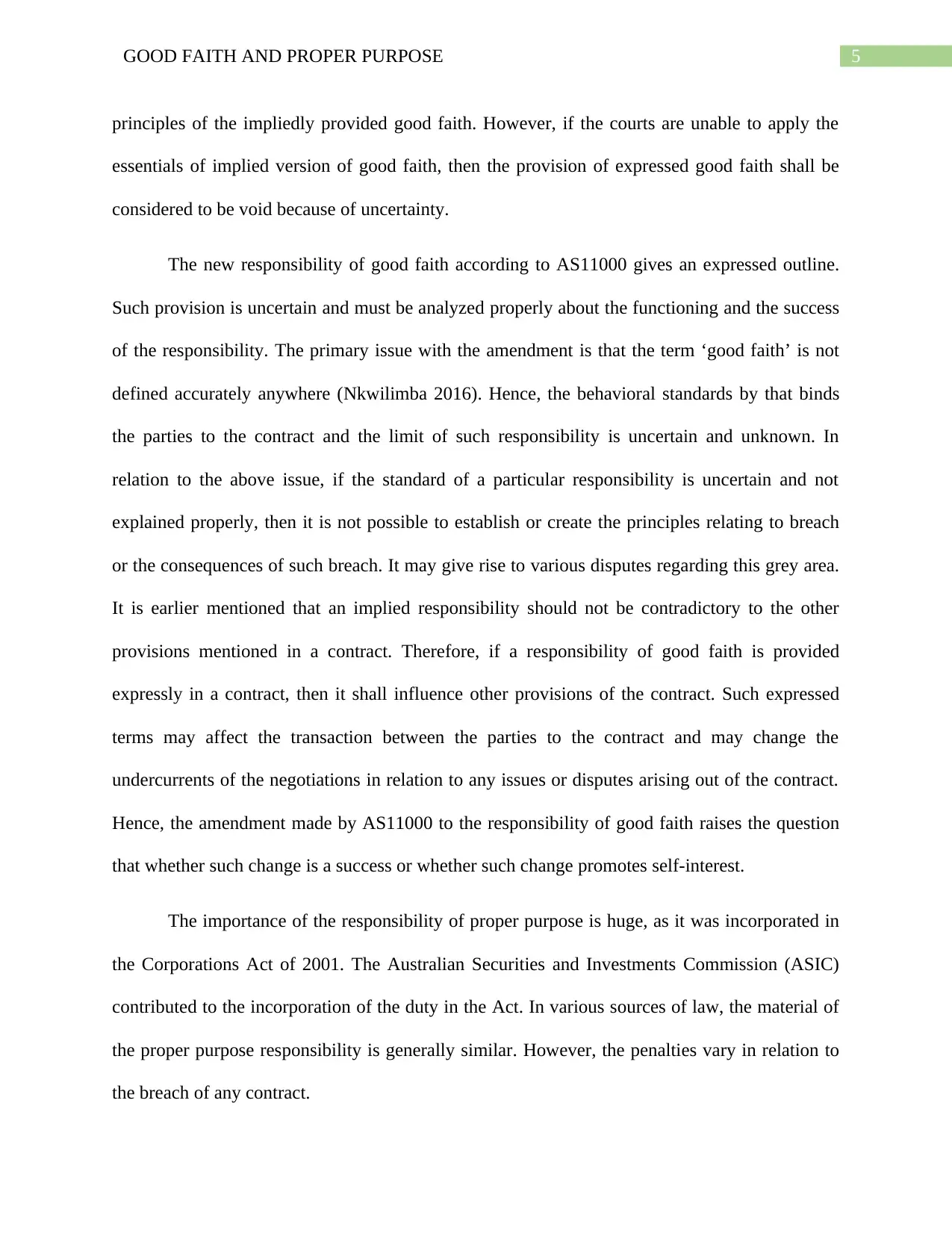
5GOOD FAITH AND PROPER PURPOSE
principles of the impliedly provided good faith. However, if the courts are unable to apply the
essentials of implied version of good faith, then the provision of expressed good faith shall be
considered to be void because of uncertainty.
The new responsibility of good faith according to AS11000 gives an expressed outline.
Such provision is uncertain and must be analyzed properly about the functioning and the success
of the responsibility. The primary issue with the amendment is that the term ‘good faith’ is not
defined accurately anywhere (Nkwilimba 2016). Hence, the behavioral standards by that binds
the parties to the contract and the limit of such responsibility is uncertain and unknown. In
relation to the above issue, if the standard of a particular responsibility is uncertain and not
explained properly, then it is not possible to establish or create the principles relating to breach
or the consequences of such breach. It may give rise to various disputes regarding this grey area.
It is earlier mentioned that an implied responsibility should not be contradictory to the other
provisions mentioned in a contract. Therefore, if a responsibility of good faith is provided
expressly in a contract, then it shall influence other provisions of the contract. Such expressed
terms may affect the transaction between the parties to the contract and may change the
undercurrents of the negotiations in relation to any issues or disputes arising out of the contract.
Hence, the amendment made by AS11000 to the responsibility of good faith raises the question
that whether such change is a success or whether such change promotes self-interest.
The importance of the responsibility of proper purpose is huge, as it was incorporated in
the Corporations Act of 2001. The Australian Securities and Investments Commission (ASIC)
contributed to the incorporation of the duty in the Act. In various sources of law, the material of
the proper purpose responsibility is generally similar. However, the penalties vary in relation to
the breach of any contract.
principles of the impliedly provided good faith. However, if the courts are unable to apply the
essentials of implied version of good faith, then the provision of expressed good faith shall be
considered to be void because of uncertainty.
The new responsibility of good faith according to AS11000 gives an expressed outline.
Such provision is uncertain and must be analyzed properly about the functioning and the success
of the responsibility. The primary issue with the amendment is that the term ‘good faith’ is not
defined accurately anywhere (Nkwilimba 2016). Hence, the behavioral standards by that binds
the parties to the contract and the limit of such responsibility is uncertain and unknown. In
relation to the above issue, if the standard of a particular responsibility is uncertain and not
explained properly, then it is not possible to establish or create the principles relating to breach
or the consequences of such breach. It may give rise to various disputes regarding this grey area.
It is earlier mentioned that an implied responsibility should not be contradictory to the other
provisions mentioned in a contract. Therefore, if a responsibility of good faith is provided
expressly in a contract, then it shall influence other provisions of the contract. Such expressed
terms may affect the transaction between the parties to the contract and may change the
undercurrents of the negotiations in relation to any issues or disputes arising out of the contract.
Hence, the amendment made by AS11000 to the responsibility of good faith raises the question
that whether such change is a success or whether such change promotes self-interest.
The importance of the responsibility of proper purpose is huge, as it was incorporated in
the Corporations Act of 2001. The Australian Securities and Investments Commission (ASIC)
contributed to the incorporation of the duty in the Act. In various sources of law, the material of
the proper purpose responsibility is generally similar. However, the penalties vary in relation to
the breach of any contract.
⊘ This is a preview!⊘
Do you want full access?
Subscribe today to unlock all pages.

Trusted by 1+ million students worldwide
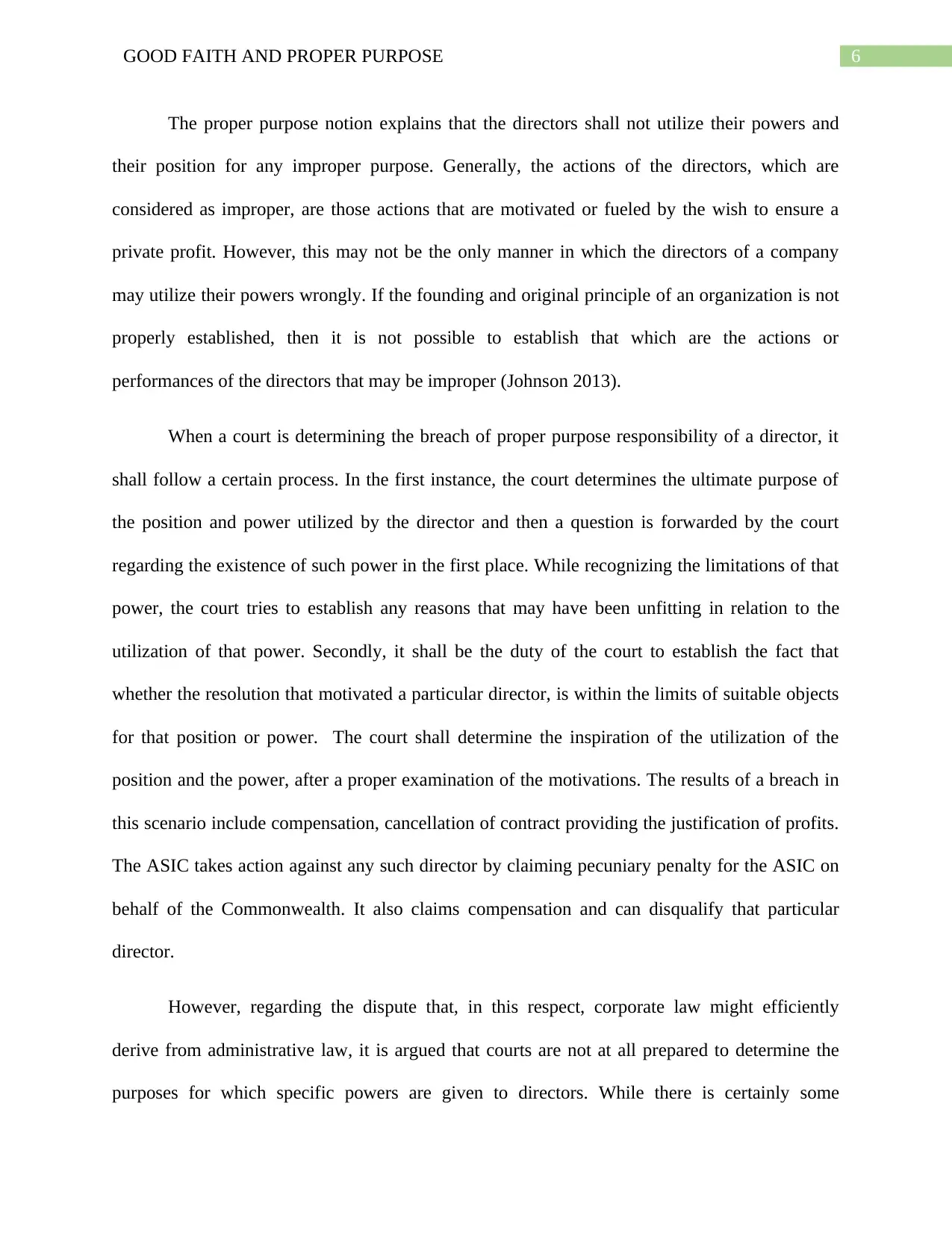
6GOOD FAITH AND PROPER PURPOSE
The proper purpose notion explains that the directors shall not utilize their powers and
their position for any improper purpose. Generally, the actions of the directors, which are
considered as improper, are those actions that are motivated or fueled by the wish to ensure a
private profit. However, this may not be the only manner in which the directors of a company
may utilize their powers wrongly. If the founding and original principle of an organization is not
properly established, then it is not possible to establish that which are the actions or
performances of the directors that may be improper (Johnson 2013).
When a court is determining the breach of proper purpose responsibility of a director, it
shall follow a certain process. In the first instance, the court determines the ultimate purpose of
the position and power utilized by the director and then a question is forwarded by the court
regarding the existence of such power in the first place. While recognizing the limitations of that
power, the court tries to establish any reasons that may have been unfitting in relation to the
utilization of that power. Secondly, it shall be the duty of the court to establish the fact that
whether the resolution that motivated a particular director, is within the limits of suitable objects
for that position or power. The court shall determine the inspiration of the utilization of the
position and the power, after a proper examination of the motivations. The results of a breach in
this scenario include compensation, cancellation of contract providing the justification of profits.
The ASIC takes action against any such director by claiming pecuniary penalty for the ASIC on
behalf of the Commonwealth. It also claims compensation and can disqualify that particular
director.
However, regarding the dispute that, in this respect, corporate law might efficiently
derive from administrative law, it is argued that courts are not at all prepared to determine the
purposes for which specific powers are given to directors. While there is certainly some
The proper purpose notion explains that the directors shall not utilize their powers and
their position for any improper purpose. Generally, the actions of the directors, which are
considered as improper, are those actions that are motivated or fueled by the wish to ensure a
private profit. However, this may not be the only manner in which the directors of a company
may utilize their powers wrongly. If the founding and original principle of an organization is not
properly established, then it is not possible to establish that which are the actions or
performances of the directors that may be improper (Johnson 2013).
When a court is determining the breach of proper purpose responsibility of a director, it
shall follow a certain process. In the first instance, the court determines the ultimate purpose of
the position and power utilized by the director and then a question is forwarded by the court
regarding the existence of such power in the first place. While recognizing the limitations of that
power, the court tries to establish any reasons that may have been unfitting in relation to the
utilization of that power. Secondly, it shall be the duty of the court to establish the fact that
whether the resolution that motivated a particular director, is within the limits of suitable objects
for that position or power. The court shall determine the inspiration of the utilization of the
position and the power, after a proper examination of the motivations. The results of a breach in
this scenario include compensation, cancellation of contract providing the justification of profits.
The ASIC takes action against any such director by claiming pecuniary penalty for the ASIC on
behalf of the Commonwealth. It also claims compensation and can disqualify that particular
director.
However, regarding the dispute that, in this respect, corporate law might efficiently
derive from administrative law, it is argued that courts are not at all prepared to determine the
purposes for which specific powers are given to directors. While there is certainly some
Paraphrase This Document
Need a fresh take? Get an instant paraphrase of this document with our AI Paraphraser
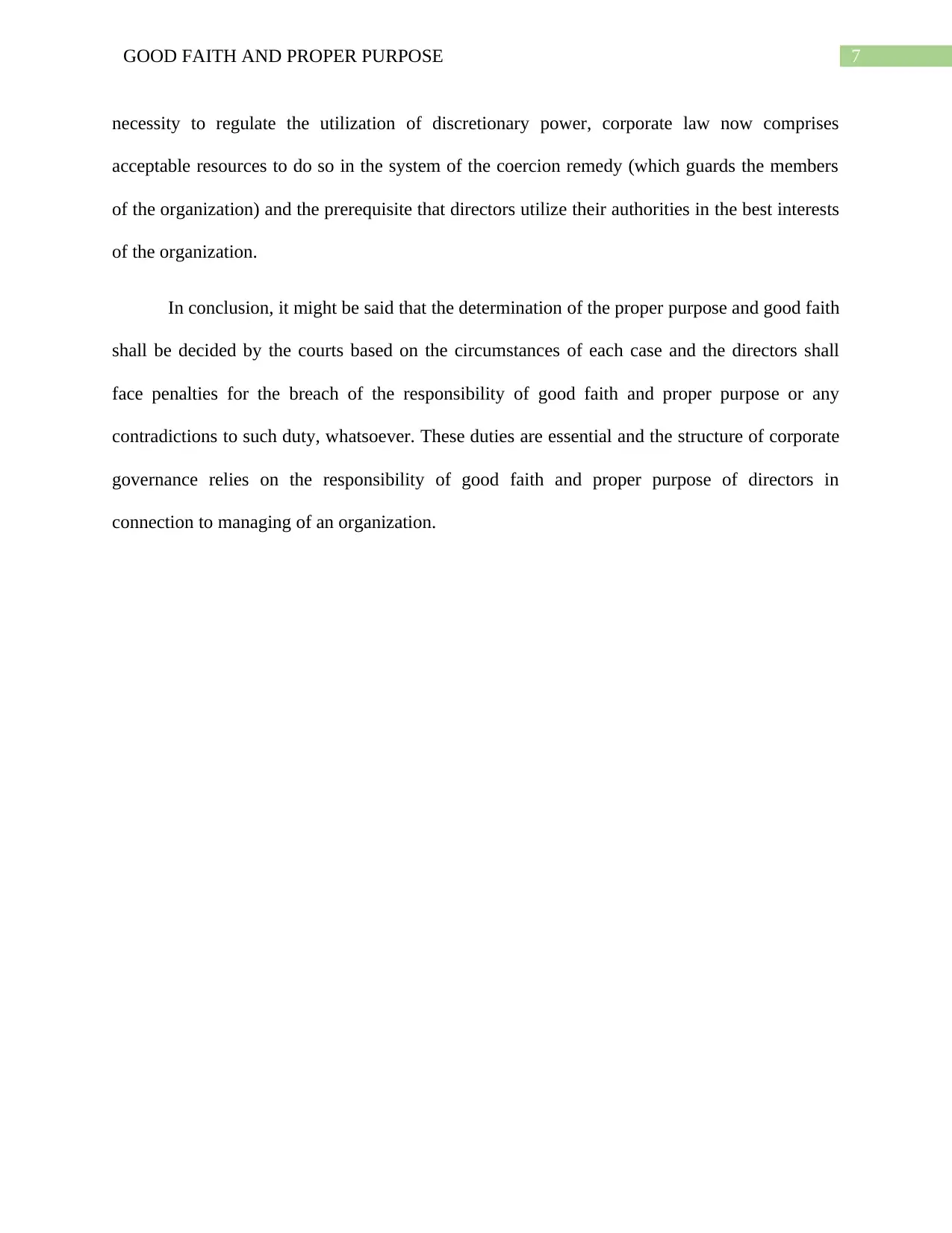
7GOOD FAITH AND PROPER PURPOSE
necessity to regulate the utilization of discretionary power, corporate law now comprises
acceptable resources to do so in the system of the coercion remedy (which guards the members
of the organization) and the prerequisite that directors utilize their authorities in the best interests
of the organization.
In conclusion, it might be said that the determination of the proper purpose and good faith
shall be decided by the courts based on the circumstances of each case and the directors shall
face penalties for the breach of the responsibility of good faith and proper purpose or any
contradictions to such duty, whatsoever. These duties are essential and the structure of corporate
governance relies on the responsibility of good faith and proper purpose of directors in
connection to managing of an organization.
necessity to regulate the utilization of discretionary power, corporate law now comprises
acceptable resources to do so in the system of the coercion remedy (which guards the members
of the organization) and the prerequisite that directors utilize their authorities in the best interests
of the organization.
In conclusion, it might be said that the determination of the proper purpose and good faith
shall be decided by the courts based on the circumstances of each case and the directors shall
face penalties for the breach of the responsibility of good faith and proper purpose or any
contradictions to such duty, whatsoever. These duties are essential and the structure of corporate
governance relies on the responsibility of good faith and proper purpose of directors in
connection to managing of an organization.
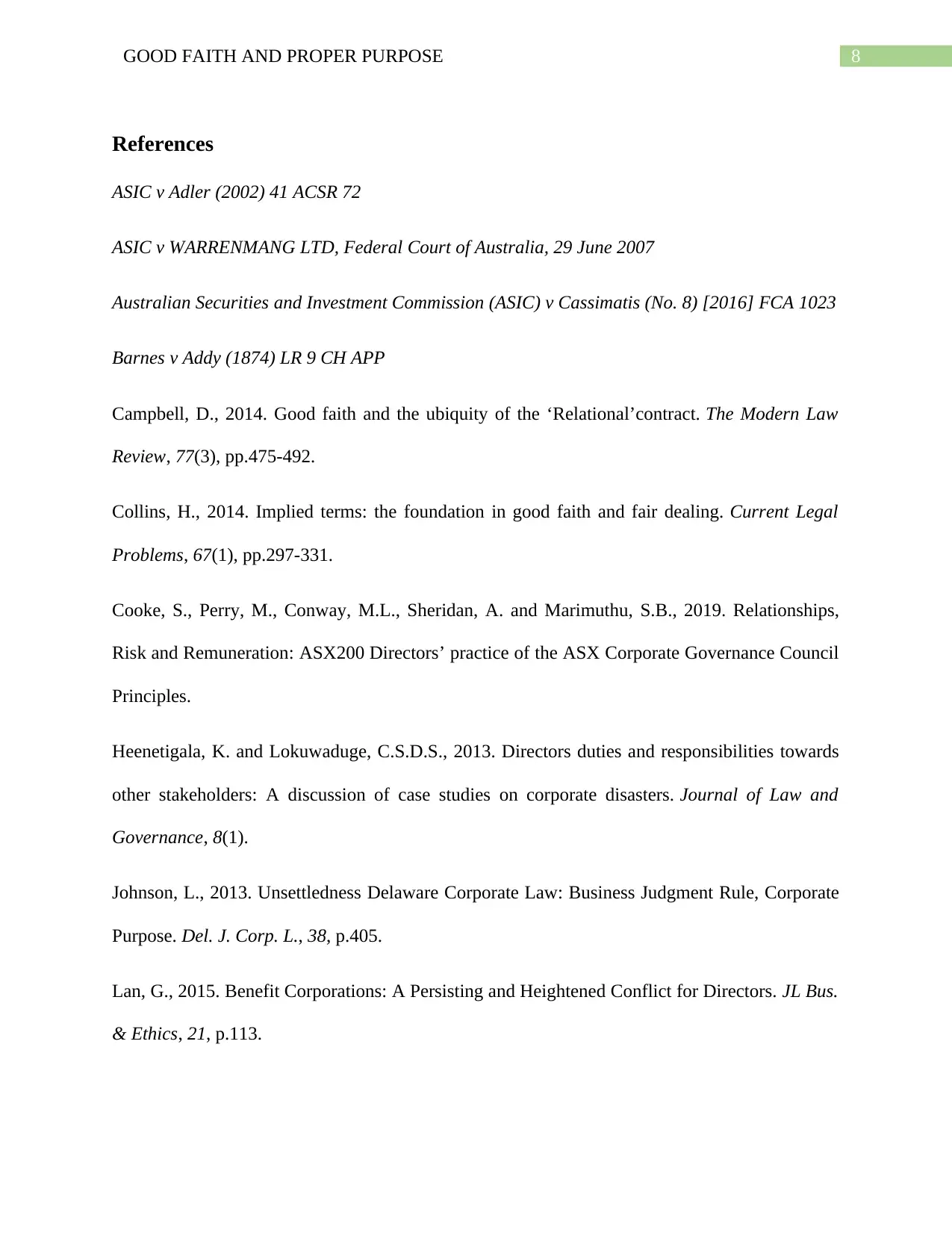
8GOOD FAITH AND PROPER PURPOSE
References
ASIC v Adler (2002) 41 ACSR 72
ASIC v WARRENMANG LTD, Federal Court of Australia, 29 June 2007
Australian Securities and Investment Commission (ASIC) v Cassimatis (No. 8) [2016] FCA 1023
Barnes v Addy (1874) LR 9 CH APP
Campbell, D., 2014. Good faith and the ubiquity of the ‘Relational’contract. The Modern Law
Review, 77(3), pp.475-492.
Collins, H., 2014. Implied terms: the foundation in good faith and fair dealing. Current Legal
Problems, 67(1), pp.297-331.
Cooke, S., Perry, M., Conway, M.L., Sheridan, A. and Marimuthu, S.B., 2019. Relationships,
Risk and Remuneration: ASX200 Directors’ practice of the ASX Corporate Governance Council
Principles.
Heenetigala, K. and Lokuwaduge, C.S.D.S., 2013. Directors duties and responsibilities towards
other stakeholders: A discussion of case studies on corporate disasters. Journal of Law and
Governance, 8(1).
Johnson, L., 2013. Unsettledness Delaware Corporate Law: Business Judgment Rule, Corporate
Purpose. Del. J. Corp. L., 38, p.405.
Lan, G., 2015. Benefit Corporations: A Persisting and Heightened Conflict for Directors. JL Bus.
& Ethics, 21, p.113.
References
ASIC v Adler (2002) 41 ACSR 72
ASIC v WARRENMANG LTD, Federal Court of Australia, 29 June 2007
Australian Securities and Investment Commission (ASIC) v Cassimatis (No. 8) [2016] FCA 1023
Barnes v Addy (1874) LR 9 CH APP
Campbell, D., 2014. Good faith and the ubiquity of the ‘Relational’contract. The Modern Law
Review, 77(3), pp.475-492.
Collins, H., 2014. Implied terms: the foundation in good faith and fair dealing. Current Legal
Problems, 67(1), pp.297-331.
Cooke, S., Perry, M., Conway, M.L., Sheridan, A. and Marimuthu, S.B., 2019. Relationships,
Risk and Remuneration: ASX200 Directors’ practice of the ASX Corporate Governance Council
Principles.
Heenetigala, K. and Lokuwaduge, C.S.D.S., 2013. Directors duties and responsibilities towards
other stakeholders: A discussion of case studies on corporate disasters. Journal of Law and
Governance, 8(1).
Johnson, L., 2013. Unsettledness Delaware Corporate Law: Business Judgment Rule, Corporate
Purpose. Del. J. Corp. L., 38, p.405.
Lan, G., 2015. Benefit Corporations: A Persisting and Heightened Conflict for Directors. JL Bus.
& Ethics, 21, p.113.
⊘ This is a preview!⊘
Do you want full access?
Subscribe today to unlock all pages.

Trusted by 1+ million students worldwide
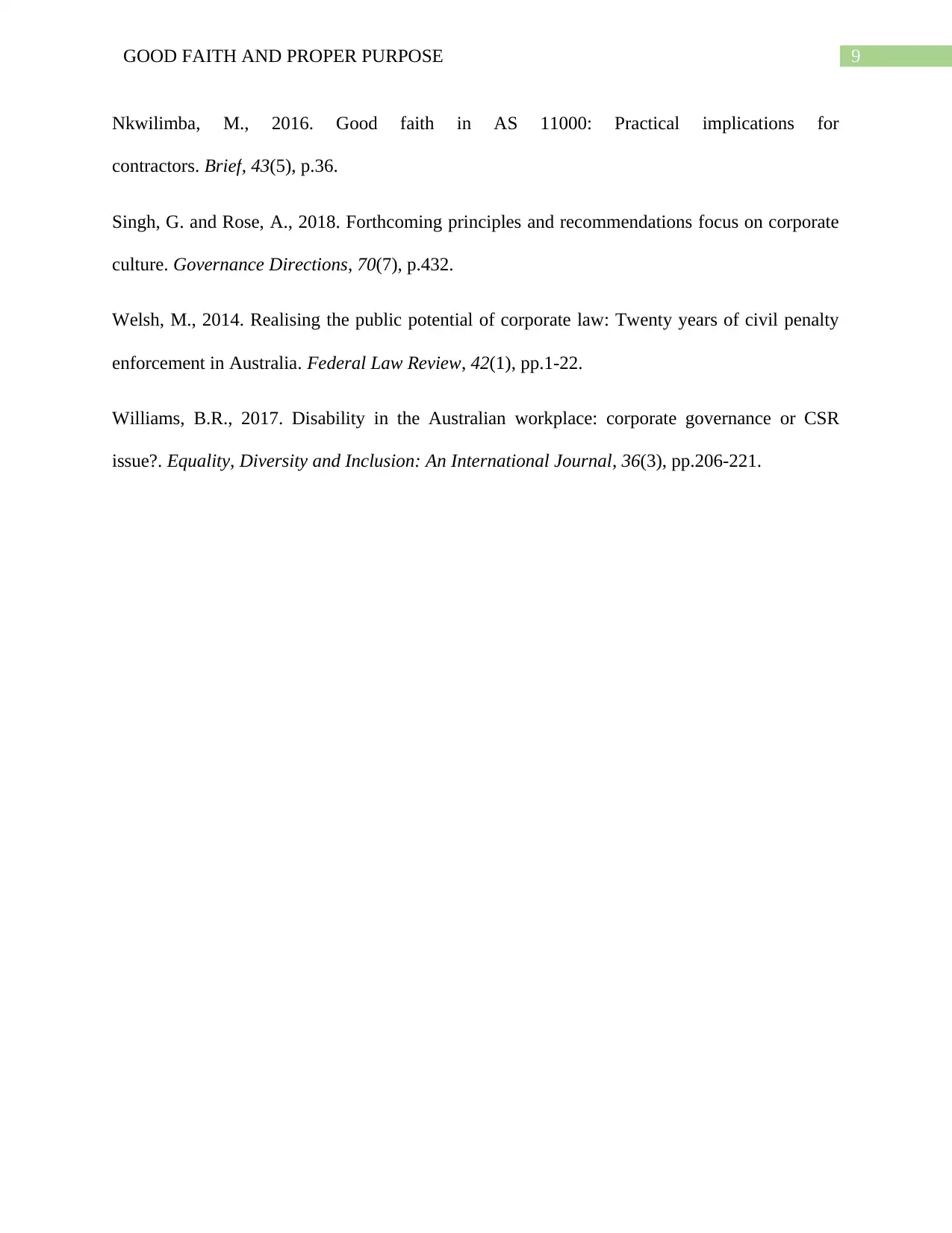
9GOOD FAITH AND PROPER PURPOSE
Nkwilimba, M., 2016. Good faith in AS 11000: Practical implications for
contractors. Brief, 43(5), p.36.
Singh, G. and Rose, A., 2018. Forthcoming principles and recommendations focus on corporate
culture. Governance Directions, 70(7), p.432.
Welsh, M., 2014. Realising the public potential of corporate law: Twenty years of civil penalty
enforcement in Australia. Federal Law Review, 42(1), pp.1-22.
Williams, B.R., 2017. Disability in the Australian workplace: corporate governance or CSR
issue?. Equality, Diversity and Inclusion: An International Journal, 36(3), pp.206-221.
Nkwilimba, M., 2016. Good faith in AS 11000: Practical implications for
contractors. Brief, 43(5), p.36.
Singh, G. and Rose, A., 2018. Forthcoming principles and recommendations focus on corporate
culture. Governance Directions, 70(7), p.432.
Welsh, M., 2014. Realising the public potential of corporate law: Twenty years of civil penalty
enforcement in Australia. Federal Law Review, 42(1), pp.1-22.
Williams, B.R., 2017. Disability in the Australian workplace: corporate governance or CSR
issue?. Equality, Diversity and Inclusion: An International Journal, 36(3), pp.206-221.
1 out of 10
Related Documents
Your All-in-One AI-Powered Toolkit for Academic Success.
+13062052269
info@desklib.com
Available 24*7 on WhatsApp / Email
![[object Object]](/_next/static/media/star-bottom.7253800d.svg)
Unlock your academic potential
Copyright © 2020–2025 A2Z Services. All Rights Reserved. Developed and managed by ZUCOL.





